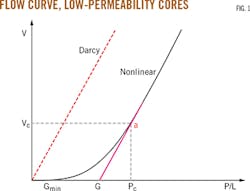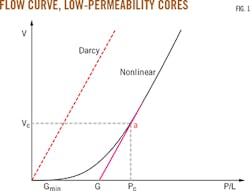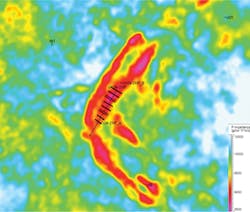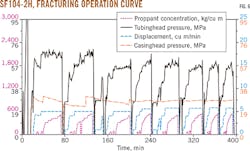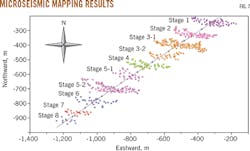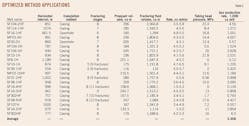Jianchun Guo
Songgen He
Yan Deng
Southwest Petroleum University
Chengdu, China
Low and ultra-low permeability sandstones account for much of the increase in gas reserves in China. Effectively developing these reservoirs has been a research focus in the region.
A novel optimization design for staged hydraulic fracturing in heterogeneous, low-permeability tight-gas reservoirs may solve key difficulties associated with non-Darcy effects and heterogeneity in these reservoirs. Improved stimulation performance outlined in this article may promote effective economic development in many of China's gas fields.
The Western-Sichuan gas field is a typical example of the Jurassic Penglaizhen (JP2) stratum, with the Xinma-Shifang section identified as a primary target. This formation has a burial depth of 800-1,900 m and a reservoir thickness of 3-40 m, contributing to a 1.23-1.4 pressure coefficient.
The Xinma-Shifang reservoir is characterized by low porosity (2.87-14.57%) and low permeability (0.015-2.81 md). Distributary channel deposits characterize the stratum. Sand bodies are stripped and lenticular, sandstone with mudstone interbedding in the vertical direction and variable reservoir types with strong heterogeneity in the plane direction.
Stimulation
Staged fracturing is an effective approach for many horizontal wells drilled in low and ultra-low permeability gas reservoirs. For the Western-Sichuan gas field in China, stimulation results have shown this process insufficient in terms of enhancing production because of poor pertinence in staged fracturing design. The design method of "one policy for one well" has proven more effective for the low-permeability Xinma-Shifang section, considering the reservoir's pseudo threshold pressure gradient (TPG), i.e., the intersection between the epitaxial line and the pressure gradient axis, and its heterogeneity.
Low production and rapid decline of vertically fractured wells have caused horizontal wells to take precedence. Design optimization of staged fracturing encounters several problems in the development of low and ultra-low permeability formations.
A complicated pore throat network featuring small pore throat radii and high pore throat ratios causes the non-Darcy percolation effect. During displacement experiments, a concave flow curve under lower pressure gradients represents the non-Darcy effect. Optimized fracturing parameters based on linear Darcy flow do not apply.
Optimized fracture designs lack pertinence in this severe heterogeneous reservoir, characterized by narrow channel sand bodies, variable reservoir types with irregular distribution, and sandstone and mudstone interbedding. The variety of strata encountered in horizontal wellbores has caused the fracture design for this reservoir to evolve from one-per-section to one-per-well. Wells must provide accurate and practical optimization that considers the non-Darcy percolation effect and the heterogeneity of the reservoir.
Design method
Nonlinear flow can be investigated by displacement experiments with cores of a specific section.
A concave flow curve shows the non-Darcy effect. V is the velocity of fluid where P/L represents the pressure gradient (ratio of displacement pressure drop and length of core). Gmin is defined as TPG, and G is defined as pseudo TPG. Vc and Pc are the velocity and pressure gradient corresponding to epitaxial point "a" (Fig. 1).
Results show lower permeability leads to a flow curve with stronger nonlinearity and the relationship between pseudo TPG and permeability is fitted by TPGpseudo=0.114×K-0.46, where K represents the permeability derived from core tests or logging. The ability to consider pseudo TPG in the production stimulation of a fractured horizontal well depends on permeability.
The location design of multistage hydraulic fractures depends on each independent percolation unit. Development of a long horizontal well divides the reservoir into multiple independent percolation units for longitudinal heterogeneity (Fig. 2).
The barrier between two percolation units is mudstone or tight sandstone with sufficient width. The critical barrier width, determined by whether the pressure wave can penetrate the barrier by production stimulation, determines percolation units.
The relationship between critical barrier width and permeability is fitted by Wcb=9 .508 × ln(K) + 41.16, where Wcb represents the critical barrier width determined by production stimulation's ability to penetrate via pressure waves. The economic cost of one hydraulic fracture provides the basis for deriving the economic-limit percolation unit width (Table 1). Once the barriers are identified, fracture stages can be optimized per spacing, length, and conductivity within a single percolation unit.
Conventional production stimulation allows identification of optimal parameters. In this article, permeability, porosity, and pseudo TPG define parameters for the variety of different reservoir types of the JP2 stratum in the Xinma-Shifang section.
Fracture spacing and production pressure identify the pressure drop gradient. Pseudo TPG can optimize fracture spacing based on reservoir properties or a combination of reservoir types. Optimized fracture lengths are estimated to determine each stage's contribution to production. The width of channel sand bodies also needs to be treated as a restrictive condition in each specific well.
These steps conclude the research process. The results allow quick and effective design of a single-well method (Fig. 3a-d). When considering a candidate horizontal well interpreting the log results is a first step. The data provide the basis for a heterogeneous reservoir model to obtain the distribution of the percolation units and determine the relationship between critical barrier width and permeability. The next step is to design fracture stages-location, length, and conductivity-for each percolation unit (Table 1). These hydraulic fracture designs are inserted into the geological model, allowing reliable prediction for production and optimization and completing fracture design. Further adjustments, however, may still be required.
Field application
The SF104-2H well served as a test application for the strategy outlined in this article. The measured depth is 2,901 m (total vertical depth 1,653 m), and the horizontal interval is 851 m. The continuity of sand bodies is generally good, and the drilling-encounter ratio is as much as 90.5%. But properties along the horizontal wellbore vary.
The logging interpretation results show that the reservoir has low permeability with a scope of 0.2-0.8 md and porosity ranging 7-12% with 34-56% gas saturation.
The lithology and property interpretation divides the horizontal reservoir section into four percolation units. Based on research results of the fracture parameters, the plan optimized 10 hydraulic fracture jobs in eight stages (Fig. 4).
The well plan combined conventional staged fracturing and limited entry fracturing technology. The width of sand body plane distribution is 220-370 m. With the target of controlling the entire sand body, the well plan optimized fracture length in the end position to 110-180 m. This stage was longer than that of the root position (Fig. 5). The outlined fracture stages yield the following operating parameters:
• Proppant volume/stage = 22-52 cu m.
• Fracturing fluid volume/stage = 140-364 cu m.
• Sand fluid ratio = 22.3-25%.
• Rate = 3.5-5 cu m/min.
The single-well design successfully distributed hydraulic fracturing throughout the wellbore, and microseismic mapping shows the staged optimization (Figs. 6 and 7).
With the successful application of optimized fracturing in well SH104-2H, the operator expanded this "one policy for one well" method throughout the Xinma-Shifang section in 20 additional wells (Table 2).
Compared with the fractured horizontal wells before the application of a single-well design, the average production rate/well increased to 23,080 cu m/d from 16,390 cu m/d of gas. Optimized fracture design on a single-well basis provided increased production as compared with a single fracture design.
Acknowledgment
This article was prepared under auspices of the Southwest Oil and Gas Co. of Sinopec and the State Key Laboratory of Oil and Gas Reservoir Geology and Exploitation at Southwest Petroleum University, Chengdu, China.
The authors
